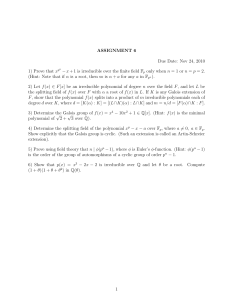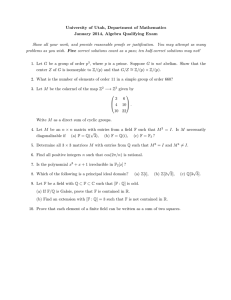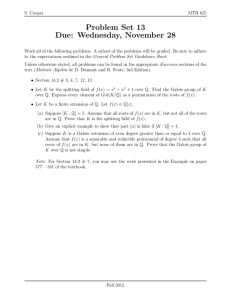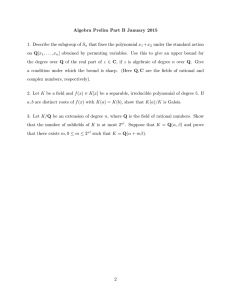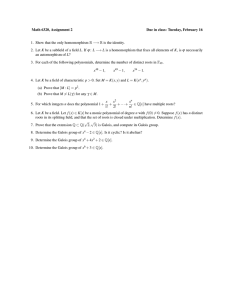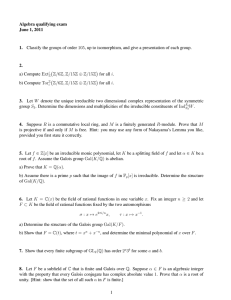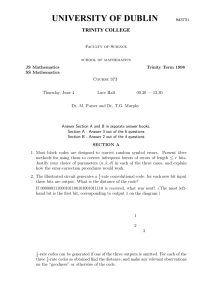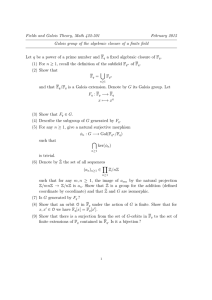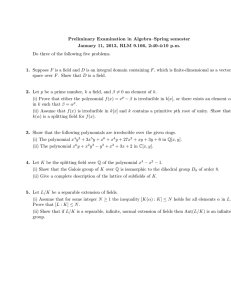Math 201C Assignment 6
advertisement
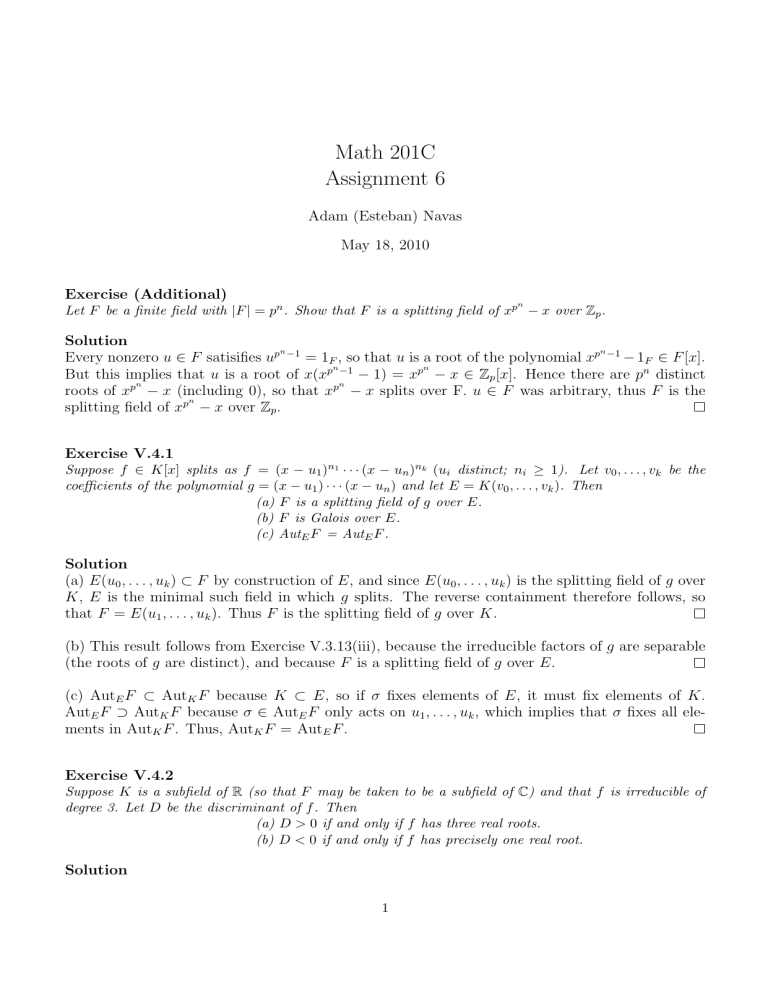
Math 201C
Assignment 6
Adam (Esteban) Navas
May 18, 2010
Exercise (Additional)
n
Let F be a finite field with |F | = pn . Show that F is a splitting field of xp − x over Zp .
Solution
n
n
Every nonzero u ∈ F satisifies up −1 = 1F , so that u is a root of the polynomial xp −1 − 1F ∈ F [x].
n
n
But this implies that u is a root of x(xp −1 − 1) = xp − x ∈ Zp [x]. Hence there are pn distinct
n
n
roots of xp − x (including 0), so that xp − x splits over F. u ∈ F was arbitrary, thus F is the
n
splitting field of xp − x over Zp .
Exercise V.4.1
Suppose f ∈ K[x] splits as f = (x − u1 )n1 · · · (x − un )nk (ui distinct; ni ≥ 1). Let v0 , . . . , vk be the
coefficients of the polynomial g = (x − u1 ) · · · (x − un ) and let E = K(v0 , . . . , vk ). Then
(a) F is a splitting field of g over E.
(b) F is Galois over E.
(c) AutE F = AutE F .
Solution
(a) E(u0 , . . . , uk ) ⊂ F by construction of E, and since E(u0 , . . . , uk ) is the splitting field of g over
K, E is the minimal such field in which g splits. The reverse containment therefore follows, so
that F = E(u1 , . . . , uk ). Thus F is the splitting field of g over K.
(b) This result follows from Exercise V.3.13(iii), because the irreducible factors of g are separable
(the roots of g are distinct), and because F is a splitting field of g over E.
(c) AutE F ⊂ AutK F because K ⊂ E, so if σ fixes elements of E, it must fix elements of K.
AutE F ⊃ AutK F because σ ∈ AutE F only acts on u1 , . . . , uk , which implies that σ fixes all elements in AutK F . Thus, AutK F = AutE F .
Exercise V.4.2
Suppose K is a subfield of R (so that F may be taken to be a subfield of C) and that f is irreducible of
degree 3. Let D be the discriminant of f . Then
(a) D > 0 if and only if f has three real roots.
(b) D < 0 if and only if f has precisely one real root.
Solution
1
(a) By Exercise III.6.16, every polynomial of odd degree in R[x] has a real root, u1 . If f factors into
(x − u1 ) and an irreducible degree 2 polynomial, then the remaining roots of f must be conjugate
to each other because they are elements of C.
( =⇒ ) Suppose D > 0 and f has only 1 real root. Let u2 = a + bi and u3 = u2 . Then
∆ = (u1 − u2 )(u1 − u3 )(u2 − u3 )
= [(u1 − a) − bi][(u1 − a) + bi][2bi]
= [(u1 − a)2 + b2 ](2bi)
=⇒ D = ∆2 < 0.
This contradicts D > 0, hence f must have 3 real roots.
( ⇐= ) If f has 3 real roots, then (u1 − u2 ), (u1 − u3 ), (u2 − u3 ) ∈ R, which implies
∆ = (u1 − u2 )(u1 − u3 )(u2 − u3 ) ∈ R.
(b) This part is true by taking the contrapositive of the forward and backward implications of
part (a), and because the roots of f in C − R are complex conjugates.
Exercise V.4.5
If charK 6= 2 and f ∈ K[x] is a cubic whose discriminant is a square in K, then f is either irreducible
or factors completely inK.
Solution
D is the square of an element in K, so by Corollary V.4.6, the Galois group of f must consist
only of even permutations. Suppose that f factors into (x − u1 )g(x), where g(x) is a degree 2
irreducible polynomial in K[x]. g must be separable because char K 6= 2, which implies that the
Galois group of g is isomorphic to Z2 , by Corollary V.4.3. Therefore there is an automorphism σ
that maps u2 to u3 , and maps u3 to u2 . But this means
σ(∆) = σ((u1 − u2 )(u1 − u3 )(u2 − u3 ))
= (u1 − u3 )(u1 − u2 )(u3 − u2 )
= −(u1 − u2 )(u1 − u3 )(u2 − u3 )
= −∆ ,
contradicting Corollary V.4.6, because σ(∆) = −∆ if and only if σ is an odd permutation, by
Proposition 4.5(ii).
Exercise V.4.10(d)
Determine the Galois group of:
√
(b) x3 − 10 over Q; over Q( 2).
Solution
2
p
√
√
2πi
char Q and char Q( (2)) 6= 2, 3, and f splits in C with 3 distinct roots: 3 10, 3 10 e 3 , and
√
2πi
3
10 e− 3 .
√
f is irreducible in both Q and Q( 2) because none of the roots of f are contained in these
fields. Therefore the discriminant, by Proposition 4.8, is −4p3 − 27q 2 , where f = x3 + px + q.
Taking p = 0 and q = 10 gives D = −2700, which is not the square of any element in either field.
Thus, the Galois group of f over both fields must be S3 , by Corollary V.4.7.
Exercise V.5.1
If K is a finite field of characteristic p, describe the structure of the additive group of K.
Solution
K is a finite field of characteristic p, so F is a simple extension of its prime subfield, Zp (Corollary
V.5.4), hence K is a vector space over Zp . By Theorem II.2.1(iii), K is isomorphic to a direct
sum of, say m, copies of Zp . This m must coincide with the integer n of Corollary V.5.2 because
Lm
n
pm =
p=1 Zp = |K| = p implies m = n.
Exercise V.5.3
If |K| = pn , then every element of K has a unique pth root in K.
Solution
p
n
n
n
For any nonzero u ∈ K, up −1 = u, which implies up = u. Hence, up −1 = up = u, so that up −1
is a pth root of u. This root is unique by the injectivity of the map u 7→ up of Lemma V.5.5.
Exercise V.5.4
If the roots of a monic polynomial f ∈ K[x] (in some splitting field of f over K) are distinct and form a
n
field, then char K = p and f = xp − x for some n ≥ 1.
Solution
The roots of f are finite, so if they form a field, R, it is finite and therefore has characteristic p.
n
The order of this field is pn − 1, so every nonzero u ∈ R satisfies up −1 = 1R . Hence every nonzero
n
n
n
root u of f is a root of xp −1 − 1R and therefore all roots of f are roots of xp − x. f and xp −1 − x
are monic and have the same roots, thus they are equal. 1 ∈ R and R has characteristic p, which
means p is the least such integer that 1 + · · · + 1 p times is equal 0. 1 is a basis of K, so this
implies p does the same to every element of K. Thus K has characteristic p.
3
Math 201C
Assignment 7
Adam (Esteban) Navas
May 27, 2010
Exercise V.6.2
If u ∈ F is purely inseparable over K, then u is purely inseparable over any intermediate field E.
Hence if F is purely inseparable over K, then F is purely inseparable over E.
Solution If u ∈ E then it is purely inseparable, so consider u ∈ F \E. Since u ∈ F is purely
inseparable over K, (x − u)m ∈ F [x] is its irreducible polynomial in K[x]. K[x] ⊂ E[x], hence
this polynomial is in E[x]. But u ∈
/ E, so that (x − u)m is also irreducible in E[x]. Thus u ∈ F is
purely inseparable over E. Arbitrariness of u implies F is purely inseparable over E.
Exercise V.6.3
If F is purely inseparable over an intermediate field E and E is purely inseparable over K, then F is
purely inseparable over K.
Solution Consider the case when char K = p 6= 0, because if char K = 0 this question is trivial.
n
Theorem 6.4(iii) implies there are integers n, m ≥ 0 such that if u ∈ F and v ∈ E, then up ∈ E
m
n
m
n+m
and v p ∈ K. Hence, for all u ∈ F , (up )p = up
∈ K, so that F is purely inseparable over
K.
Exercise V.6.5
n
If char K = p 6= 0 and a ∈ K but a ∈
/ K p n , then xp − a ∈ K[x] is irreducible for every n > 1.
n
Solution Let f (x) = xp − a and let ui be the roots of f in the splitting field F = K(u1 , . . . , upn )
of K. This splitting field is purely inseparable over K, so any ui ∈ F has minimal polynomial
r
f˜ = xp − b ∈ K[x] by Theorem 6.4(ii). Since f˜ is the minimal polynomial of ui and ui is a root
of f , we know that r ≤ n. If r = n then f (u) = f˜(u) = 0, which implies f (u) − f˜(u) = a − b = 0,
n
i.e., that f˜(x) = f (x) = xp − a is irreducible.
r
n
n−r
r
n−r
n
Suppose that r < n. Then upi = b ∈ K and upi = a ∈ K. Hence bp
= (upi )p
= upi = a.
n−r−1
n−r−1 p
But b ∈ K ⇒ bp
∈ K ⇒ a = (bp
) ∈ K, so that a is an element of K p , contradicting
p
a∈
/K .
Exercise V.6.11
If f ∈ K[x] is irreducible of degree m > 0, and char K does not divide m, then f is separable.
1
Solution By Theorem III.6.10, an irreducible polynomial in K[x] is separable if and only if
f 0 6= 0. Since f has degree m > 0, the highest degree term of f 0 looks like mam xm , where am ∈ K
is the coefficient of xm . Since char K - m, m cannot be written as a product of char K and an
integer n. Thus, f 0 is never 0, so that f is separable.
Exercise 1 (Additional)
Let K be an infinite field. Show that if the extension F ⊃ K has finitely many intermediate fields
then F is a simple extension of K.
Solution We proceed by picking a u ∈ F such that [K(u) : K] is maximal and assuming F 6= K(u)
to derive a contradiction.
If F 6= K(u), then there exists v ∈ F \K(u). Since K is an infinite field with only finitely
many intermediate fields, there exists a, b ∈ K, a 6= b, such that K(u + av) = K(u + bv). If
there were no such a and b, then the number of intermediate fields of F ⊃ K would be infinite.
Now, (a − b)v = u − u + av − bv = (u + av) − (u + bv) ∈ K(u + av). K(u + av) is a field and
0 6= (a − b) ∈ K(u + av), so that v = (a − b)(a − b)−1 v ∈ K(u + av). Hence u = (u + av) − av ∈
K(u + av) =⇒ K ⊂ K(u) ( K(u + av). But then we have [K(u + av) : K] > [K(u) : K],
contradicting maximality of [K(u) : K].
Exercise 2 (Additional)
√
Find a primitive element of the extension Q( 2, i) ⊃ Q. Find the minimal polynomial of this primitive
element Q[x].
√
√
Solution There are only finitely many intermediate fields of Q( 2, i) ⊃ Q, hence Q( 2,√
i) is a
simple extension of Q by Proposition V.6.15(ii)(⇐). There exists u ∈ C√such that Q(u) = Q( 2, i).
Let u = √12 + i √12 . (1) and (4) of the following relations show that Q( 2) and Q(i) are subsets of
Q(u):
1
1
1
1
1
1
2
√ + i√
u = √ + i√
(1)
= +i− =i
2
2
2
2
2
2
1
1
1
1
3
u = i √ + i√
= −√ + i√
(2)
2
2
2
2
u4 = u2 u2 = i2 = −1
(3)
√
1
1
1
1
1
1
u + u7 = √ + i √ + u3 u4 = √ + i √ − − √ + i √
= 2
(4)
2
2
2
2
2
2
√
√
√
u ∈
√ Q( 2, i), so that Q(u) ⊂ Q( 2, i). Q(u) ⊃ Q( 2, i)√because, by relations (1) and (4),
Q( 2, i) is generated by elements of Q(u). Thus, Q(u) = Q( 2, i), so that u is primitive.
The minimal polynomial of u is f (x) = x4 + 1 ∈ Q[x] because f is irreducible and u4 is the first
power of u in Q.
2
Math 201C
Assignment 8
Adam (Esteban) Navas
May 31, 2010
Exercise V.7.2
Let F be a finite dimensional extension of a finite field K. The norm NK F and the trace TK F
(considered as maps F → K) are surjective.
Solution Since F ⊃ K is a finite dimensional extension of a finite field K, by proposition
V.5.10, F is finite and Galois over K, with AutK F cyclic. Therefore by Theorem V.7.2, we have
TK F (u) = σ1 (u) + · · · + σn (u), where |AutK (F )| = r.
Consider n = 1 + · · · + 1, n times, an element of K. Then kn−1 + · · · kn−1 = k(n−1 + · · · +
n−1 ) = kn−1 (1 + · · · + 1) = kn−1 n = k. Thus, since σi fix all elements of K, TK F (kn−1 ) =
σ1 (kn−1 ) + · · · + σn (kn−1 ) = kn−1 n = k, so that the trace is surjective.
K is a finite field, so |K| = pn for some n ≥ 1. Let q = pn . The generator of AutK (F ),
σ(x) = xq , is a Zp -automorphism, so that
NK F (x) = σ1 (x) · · · σn (x)
=
=
r−1
Y
i=0
r−1
Y
σ i (x)
xqi
i=0
Pr−1
=x
0
qi
q r −1
= x q−1
is a homomorphism. By Additional Exercise 3, K × and F × are cyclic. Let u0 be a generator of
k
r −1
F × , with order q r − 1. If NK F (u0 ) = 1, then k qq−1
is divisible by q r − 1. But this only happens
if q − 1|k, which implies NK F (u0 ) has order q − 1 = pn − 1, i.e., that NK F (u0 ) is a generator of
K × . Thus, NK F (x) is surjective.
Exercise V.7.7
If n is an odd integer such that K contains a primitive nth root of unity and char K 6= 2, then K
also contains a primitive 2nth root of unity.
Solution Let ζ be a primitive nth root of unity, so that {ζ, ζ 2 , . . . , ζ n = 1} are roots of unity in K.
Consider roots of x2n −1 = (xn −1)(xn +1) ∈ K[x], R = {−ζ, −ζ 2 , . . . , −ζ n = −1}∪{ζ, ζ 2 , . . . , ζ 1 =
1
1}, generated by −ζ ∈ K. char K 6= 2 so that −1 and 1 are distinct elements in K, and for all
i, j < n, 1 = (ζ i )n 6= (−ζ j )n = −(ζ j )n = −1, so that each element of R is distinct. Thus, −ζ is a
2nth root of unity in K.
Exercise V.7.8
If F is a finite dimensional extension of Q, then F contains only a finite number of roots of unity.
Solution If F is a finite dimensional extension of Q then, since Q is perfect, F ⊃ Q is a separable
extension. By Proposition V.6.15(i), this extension must therefore be simple, i.e., F = Q(u) for
a primitive element u. Since this extension is simple, if F contains a primitive nth root of unity,
it only contains other dth roots of unity such that d|n, for some maximal n. If F contains such a
primitive nth root of unity and n is odd, then by Lemma V.7.10(ii) and Exercise V.7.7, there are 2n
roots of unity. If n is even then there are only n roots of unity, {1, e2πi/n , (e2πi/n )2 , . . . , (e2πi/n )n−1 }.
Lastly, if F has no primitive root of unity, 1 and −1 are the only roots of unity.
Exercise 1 (Additional)
Let F be a field and σ1 , σ2 , . . . , σn be distinct automorphisms of F . Let a1 , a2 , . . . , an ∈ F . Prove that
if
a1 σ1 (u) + a2 σ2 (u) + · · · + an σn (u) = 0
for all u ∈ F , then a1 = a2 = · · · = an = 0.
Solution Suppose that this set of distinct automorphisms is dependent, i.e., that there exists
distinct σi and 0 6= ai ∈ F such that n > 1 is minimal. Hence for σ1 (v) different from σ2 (v) for
some v ∈ F , we would have:
a1 σ1 (u)σ1 (v) + · · · + an σn (u)σn (v) = 0 , and
a1 σ1 (u)σ1 (v) + · · · + an σn (u)σ1 (v) = 0
so that a2 [σ2 (v) − σ1(v)]σ2 (u) + · · · + an [σn (v) − σ1 (v)]σn (u) = 0, for all u ∈ F and not all zero
coefficients, contradicting minimality of n.
Exercise 2 (Additional)
Let F ⊃ K be a cyclic extension of degree n with σ being a generator of AutK (F ). Prove that NK F = 1
if and only if there exists v ∈ F such that u = vσ(v)−1 .
Solution (=⇒) Suppose u = vσ(v)−1 , so that σ n (v −1 ) = v −1 , σ(v −1 ) = σ(v)−1 , and σ i (vσ(v)−1 ) =
σ i (v)σ i+1 (v)−1 . Therefore,
NK F (u) = (vσ(v)−1 )(σvσ 2 (v)−1 )(σ 2 vσ 3 (v)−1 ) · · · (σ n−1 vσ n (v)−1 )
= (v)(σ(v)−1 σv)(σ 2 (v)−1 σ 2 v)(σ 3 (v)−1 σ 3 v) · · · (σ n−1 (v)−1 σ n−1 v)v −1
= vv −1 = 1
(⇐=) Suppose N (u) = 1. Then u 6= 0. By linear independence of distinct automorphisms of
a field, there must be a y ∈ F such that:
0 6= v = uy + (uσu)σy + (uσuσ 2 u)σ 2 y + · · · + (uσu · · · σ n−2 u)σ n−2 y) + (uσu · · · σ n−1 u)σ n−1 y
2
Since (uσu · · · σ n−1 u)σ n−1 y = NK F (u)σ n−1 y = σ n−1 y, u−1 v = σv. By a long calculation, this
implies u = vσ(v)−1 , where σ(v) 6= 0 by injectivity of σ.
Exercise 3 (Additional)
Let F be any field and F × be the multiplicative group of non-zero elements of F . Show that every
finite subgroup of F × is cyclic.
×
Solution Let G < F × be a finite subgroup
L Lof F . Since F is a field, this subgroup is abelian,
so that it is isomorphic to H = Zm1
· · · Zmk , where m1 | · · · |mk . mk H = 0, so that every
mk
element u in G must be a root of x − 1, which has at most mk distinct roots. Thus, k = 1 and
G is cyclic.
3
Math 201C
Assignment 8
Adam (Esteban) Navas
June 5, 2010
Problem 1
Show that the extension Q is infnite dimensional over Q. Deduce that the Galois group AutQ (Q) is
infnite.
Solution Suppose by contradiction that Q ⊃ Q is finite dimensional. Then [Q : Q] = k, for some
k > 1. Consider the tower of field extensions
√
√
√
√
2i
2i−1
4
Q ⊃ · · · ⊃ Q( 2) ⊃ Q(
2) ⊃ · · · Q( 2) ⊂ Q( 2) ⊃ Q
√
√
i
i−1
The irreducible polynomial of each extension Q( 2 2) ⊃ Q( 2 2) has degree 2, because x2 −2i−1 is
√
√
√
√
i
i−1
i
i−1
irreducible in Q( 2 2) ( 2 2 is not an element of Q( 2 2)). Hence the dimension of Q( 2 2) ⊃ Q
is 2i for all i.
√
2n+1
n−1
n
There must exist
an
n
such
that
2
≤
k
<
2
.
Since
2 ∈ Q, we √
must have that Q is
√
n
2n
an extension of Q( 2√
2).
So,
consider
the
tower
of
extension
fields,
Q
⊃
Q(
2) ⊃ Q. This tower
√
√
2n
2n
2n
n
shows that [Q : Q( 2)][Q( 2) : Q] = 2 [Q : Q( 2)] > k. But we now have a contradiction to
our assumption that [Q : Q] = k. Thus, Q must be an infinite dimensional extension field of Q.
Problem 2
Let E be the splitting field of (x3 − 2)(x2 − 3) over Q. Determine the Galois group G = AutQ (E).
Describe 3 nontrivial subgroups of G and the corresponding intermediate fields of the extension E ⊃ Q.
Solution The Galois group of (x3 − 2)(x2 − 3) over Q is Z2 × S3 , because every Q-automorphism
is determined by its action on the roots of the irreducible factors of (x3 − 2)(x2 − 3). The Galois
group of x2 − 3, say H1 , is Z2 (char Q 6= 2), and the Galois group of x3 − 2 over Q, call it H2 , is
S3 , by Corollary V.4.7, which yields the Galois group of the polyonomial.
Corollary V.4.7 concludes such a Galois group for x3 − 2 because the discriminant of x3 − 2
is -108, which is not the square of any element of Q. We also have a product
√ rather
√ than a direct
sum, because
the
intersection
of
H
and
H
is
not
trivial
(if
σ
∈
H
sends
3
to
−
3, then it also
1
2
1
√
√
3
3
2πi/3
2πi/3
sends 2e
to − 2e
, so that it is an element of both H1 and H2 ).
√
√
√
√
3
3
Consider
√ the intermediate fields Q( 3),
√ Q( 2), and Q( 2, 3). The automorphisms in
AutQ (Q( 3)) are precisely
√ those that fix 3, and act any way on the roots of the irreducible
factor x3 − 2. Hence Q( 3) corresponds to the subgroup {e} × S3 .
1
√
√
√
Denote the automorphisms fixing√ 3 2 and permuting the (complex) roots of x2 + 3 2x + ( 3 2)2
h(23)i,
by the permutation (23). Then Q( 3 2) corresponds√ to the√subgroup Z2 × √
√ because it is
3
3
3
2
2
2
determined by its action on the roots of (x −3)(x + 2x+( 2) ). Lastly, Q( 2, 3) corresponds
to the subgroup
{e} × h(23)i because each automorphism is determined by its action on the roots
√
√
3
3
2
of x + 2x + ( 2)2 .
Problem 3
Let K be a finite field with |K| = q . Let K be an algebraic closure of K . Frobenius automorphism
F r is the K-automorphism of K which is defined by the formula:
F r(u) = uq .
Let E be an intermediate field K ⊃ E ⊃ K such that [E : K] is finite. Show that F r generates the Galois
group AutK (E).
Solution K is a finite field, hence it has order q = pn for some prime p and integer n ≥ 1.
Since E is a finite dimensional extension of K, say [E : K] = m, it must also be a finite field of
characteristic p, of order |E| = pm , m ≥ n. Since E is a finite dimensional extension of a finite
field, by Proposition V.5.10, E is Galois over K and AutK E is cyclic of order [E : K] = m, by the
Fundamental Theorem of Galois Theory.
n
F r is a Zp -automorphism of E, by Lemma V.5.5, and F r fixes elements of K because up = u
for all u ∈ K. Hence F r is also a K-automorphism of E. F rm = 1 because |E| = pm , and E is
m
a splitting field of xp − x over Zp , so that it has pm distinct roots. If the order of F r is some
k
integer k < m, then xp − x would have pm distinct roots, contradicting Theorem III.6.7. Thus,
F r has order m, so that it generates AutK E.
Problem 4
Show that every field K of characteristic zero is perfect.
Solution It must be shown that all algebraic extensions of K are separable, which will be true
if all irreducible polynomials in K[x] are separable. If f ∈ K[x] is irreducible, suppose it is not
separable. This would imply that f has multiple roots. If f has a multiple root, c, then there is
an integer m > 1 such that in a splitting field of f ,
f (x) = (x − c)m g(x) =⇒ f 0 (x) = m(x − c)m−1 g(x) + (x − c)m g 0 (x)
= (x − c)[m(x − c)m−1 g(x) + (x − c)m−1 g 0 (x)].
We therefore have f is not relative prime to f 0 , by the contrapositive of Theorem III.6.10(ii), so
that there is an h ∈ K[x] such that h|f and h|f 0 . f is irreducible, so that h is an associate of f ,
with degree bigger than f 0 . The only way for h to divide f 0 is if f 0 is the 0 polynomial, i.e.,
0 ≡ f 0 = a1 + 2a2 x + · · · + nan xn−1
⇒ a1 = 2a2 = · · · = nan = 0
Since char K = 0, ai = 0 for all 1 ≤ i ≤ n, therefore f is the constant polynomial a0 , contradicting
f having a multiple root. Thus, f is separable, so that K is perfect.
2
Problem 5
n
Let K be a field of positive characteristic p. Let K pn be the set of all elements of the form up where
u ∈ K . Show that K pn is a subfield of K . Prove that K is a purely inseparable extension of K pn .
n
Solution K pn is clearly a subset of K. The map φ : K → K defined by φ(u) = up is a Zp monomorphism of fields. φ is isomorphic onto image, K pn , hence it preserves the additive group
structure of (K, +) and the multiplicative group structure of (K × , ·), so that K pn is a subfield of
K.
n
For every element u ∈ K, up ∈ K pn , hence K is a purely inseparable extension of K pn , by
Theorem V.6.4(iii).
Problem 6
Let K be an algebraic closure of the field K and σ ∈ AutK (K). Consider the field
F = {u ∈ K : σ(u) = u}
Prove that every finite dimensional extension E of F is cyclic.
Solution Let Ẽ be the normal closure of E. If it can be shown that Ẽ is Galois over F and
AutF Ẽ is cyclic (hence abelian), then every subgroup of AutF Ẽ will be normal. In particular, by
Theorem V.2.5(ii), AutE Ẽ / AutF Ẽ implies AutF Ẽ/AutE Ẽ ∼
= AutF E. Quotients of cyclic groups
are cyclic, so that AutF E will be cyclic.
It must be shown that (AutF Ẽ)0 = F for Ẽ to be Galois over F . (AutF Ẽ)0 ⊃ F is trivial.
For the reverse containment, if u ∈ AutF Ẽ)0 , then for the σ ∈ AutF K, σ|Ẽ : Ẽ → K is an
F -monomorphism of fields. Ẽ is a normal extension, so by Theorem V.3.14(iii), σ is actually an
Ẽ-automorphism of Ẽ. Hence, σ(Ẽ) = Ẽ ⇒ σ(u) = u, so that Ẽ is Galois over F .
Consider the subgroup of AutF Ẽ generated by σ, hσi < AutF Ẽ, of order |hσi| = n. The fixed
field of hσi is hσi0 = {u ∈ Ẽ : σ i (u) = u ∀i = 1, . . . , n}. hσi0 = F because if u ∈ F , then σ i (u) = u
for all i; and if u ∈ hσi0 , then σ(u) = u ⇒ u ∈ F .
Ẽ is a finite dimensional extension of F because E is, and Ẽ is Galois, hence by Lemma
F Ẽ|
V.2.10(iii) all intermediate fields and all subgroups are closed. [AutF Ẽ : hσi] = |Aut
< ∞,
|hσi|
so that by Lemma V.2.10(ii), [AutF Ẽ : hσi] = [hσi0 : F ] = [F : F ] = 1. But, Lagrange’s
Theorem gives |AutF Ẽ| = [AutF Ẽ : hσi]|hσi| = |hσi| = n. Thus, AutF Ẽ is cyclic, and by the first
paragraph, AutF E is cyclic for any finite dimensional extension E over F .
Problem 7
We proved in class that if K̃ is a Galois radical extension of K then AutK (K̃) is solvable. Using this
result, prove that if F is a radical extension of K and E is an intermediate field of the extension F ⊃ K
then AutK (E) is solvable.
Solution Let K0 = (AutK E)0 . Then K ⊂ K0 , E is Galois over K0 , AutK E = AutK0 E, and F is
a radical extension of K0 (K0 is an intermediate field, so this follows by Exercise V.9.1). Hence
we may assume WLOG that K = K0 , which means that E is Galois over K and hence by Lemma
3
V.2.13 that E is a stable intermediate field. Let N be the normal closure of F over K, so that by
Lemma V.9.3 we have N is a radical extension of K. Since E is stable, σ|E : AutK N → AutK E
is a homomorphism; and by Theorem V.3.8, N is a splitting field over K implies σ extends to a
K-automorphism of N . Hence, σ|E is surjective. The homomorphic image of a solvable group is
solvable, so we must show that AutK N is solvable. If K1 = AutK N , then N is a radical Galois
extension of K1 and AutK1 N = AutK N . Thus, by our assumption that any such extension (in
particular, AutK1 N ) has a solvable Galois group, AutK N is solvable.
Problem 8
Let K be a field, F = K(x1 , . . . , xn ) be the field of rational functions in n indeterminates, and E ⊂ F
be the subfield of all symmetric rational functions in K(x1 , . . . , xn ) (See the Appendix of V.2). Show
that {x1 , . . . , xn } is a transcendence basis of F over K. Show that the elementary symmetric functions
f1 , f2 , . . . , fn form a transcendence basis of E. Do the functions f1 , f2 , . . . , fn also form a transcendence
basis of F ?
Solution {x1 , . . . , xn } is a transcendence basis of K(x1 , . . . , xn ) because it is algebraically independent: if f (x1 , . . . , xn ) = 0, then clearly f ∈ K[y1 , . . . , yn ] is 0. Suppose {x1 , . . . , xn , f /g} is a
bigger algebraically independent set, where f, g 6= 0 are in K[x1 , . . . , xn ]. Then h(y1 , . . . , yn+1 ) =
g(y1 , . . . , yn )yn+1 − f (y1 , . . . , yn ) ∈ K[y1 , . . . , yn , yn+1 ] is a nonzero polynomial with:
f (x1 , . . . , xn )
− f (x1 , . . . , xn )
g(x1 , . . . , xn )
= f (x1 , . . . , xn ) − f (x1 , . . . , xn )
= 0,
h(x1 , . . . , xn , f /g) = g(x1 , . . . , xn )
so that {x1 , . . . , xn , f /g} is algebraically dependent.
By Theorem V.2.18 of the appendix, E = K(f1 , . . . , fn ). If h(f1 , . . . , fn ) = 0, then clearly h ∈
K[y1 , . . . , yn ] is the 0 polynomial, just as before. Hence {f1 , . . . , fn } is algebraically independent
over K. Using the same trick as in the previous paragraph, suppose {f1 , . . . , fn , φ/ψ} is a bigger
algebraically independent set, where φ, ψ ∈ K[y1 , . . . , yn ] and ψ 6= 0. Then h(y1 , . . . , yn+1 ) =
ψ(y1 , . . . , yn )yn+1 − φ(y1 , . . . , yn ) ∈ K[y1 , . . . , yn , yn+1 ] is a nonzero polynomial with:
φ(f1 , . . . , fn )
− φ(f1 , . . . , fn )
ψ(f1 , . . . , fn )
= φ(x1 , . . . , xn ) − φ(x1 , . . . , xn )
= 0.
h(f1 , . . . , fn , φ/ψ) = ψ(f1 , . . . , fn )
Thus, {f1 , . . . , fn } is a transcendence basis of E over K.
K(x1 , . . . , xn ) is algebraic over E because [K(x1 , . . . , xn ) : E] ≤ n!, and
n = tr.d.(F/K) = tr.d.(F/E) + tr.d.(E/K)
= 0 + tr.d.(E/K)
⇒ tr.d.(E/K) = n.
It was already shown that T = {f1 , . . . , fn } is algebraically independent over K. If T ⊂ T 0 , where
T 0 is a transcendence basis of F over K, then |T 0 | = |{x1 , . . . , xn }| = n, so that T = T 0 . Thus,
{f1 , . . . , fn } is a transcendence basis of F over K.
4
